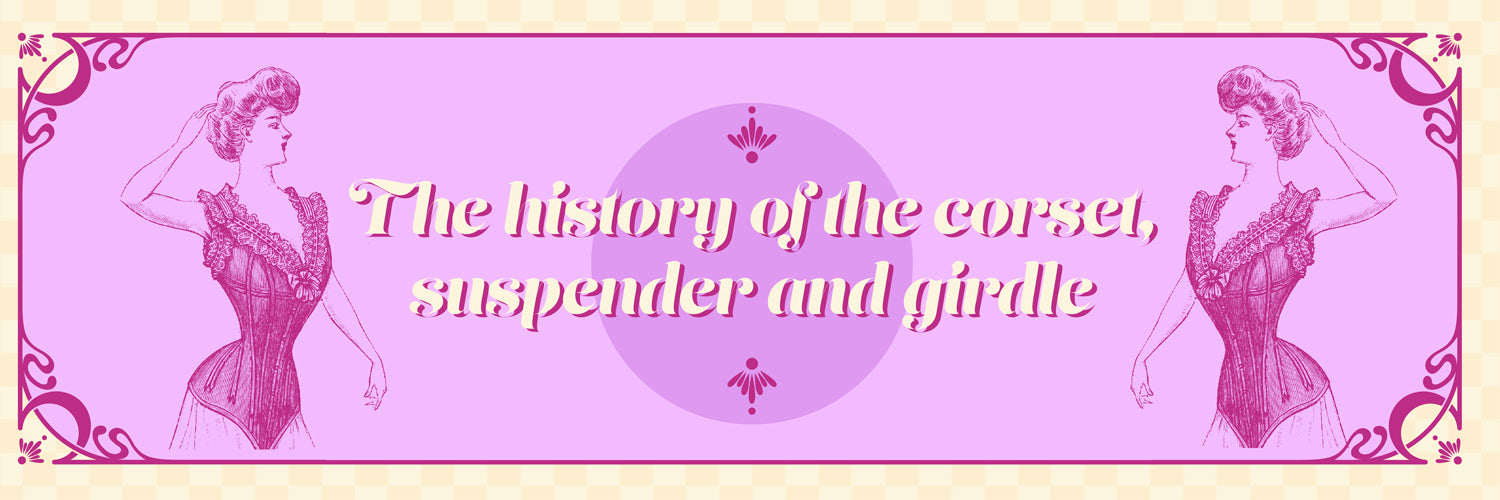The History Of The Corset, Suspender and Girdle
Corset History
The corset trend has been around for centuries; however, this iconic garment has not always been the epitome of sexy! So how have corsets evolved over the years?
The first acknowledgement of corsets, also known as ‘stays’ (The mother of corsets) dates back to the 17th century. They were a conical shape commonly worn underneath a dress or as a bodice to help support a woman’s figure. The stay was a stiff, fully boned garment stitched by hand that had no intention of creating an ideal feminine silhouette. The stay pushed the bust upwards while the back was high cut, along with the straps this corset shape encouraged women’s posture and kept the back straight.
From the 1800’s corsets were used as a tool to allow women to achieve the popular silhouette at the time! The Victorian hourglass figure as we know today emerged into fashion.(As seen on image 1) Before Pilates and BBL’s women would achieve a smaller waist and emphasized bust/hip with the corset! . The emphasis in this period is on the bust, cups are built into the corset and stiff wooden busks are used to keep the breasts apart.
With the advent of the Victorian period, the waist moves back down and more recognisable corsets come into use. These make use of new innovations – metal eyelets and metal busks which use hooks to allow the corset to be fastened at the front, as well as laced at the back. It is during this period that tight-lacing becomes popular emerging the hourglass figure!
I know I said I would be exploring the history of suspenders and girdles (I promise I’m getting there) but without the corset these popular lingerie pieces would not be what they are today!
The 1900’s saw the appearance of the “S” shape also known as “The new figure” that consisted of a straight-fronted corset which started lower on the bustline than the corsets had a few years previously.(Seen on image 2) The shape of the corset pushed the chest forward and the hips backwards. This then leads into the 1910 evolution of “The new teens” a silhouette that demanded an extension of the corset to the tops of the thighs that would shrink the hip… This would eventually evolve into the girdle.

Corset to Girdle
The girdle is a popular garment from the 1920’s aimed at compressing the hips allowing women to achieve more slender ‘natural’ silhouettes. The invention of elastic in this era allowed for flexible corsets, shapewear and girdles. With the emergence of ‘flapper girls’ and looser fitting clothing, the girdle introduced a new ‘boyish’ style silhouette for women. Many of these girdle’s were made from silk and satin and allowed for less restriction compared to it’s corset cousins! This change demonstrates an important mark in women’s lingerie as comfort became more of a priority!
Girdle to suspender belt
During the 1960s stockings were a must and girdles constantly evolved in order to remain practical. Girdles became shorter and sat just around the waist- giving us the suspender belt we know today! However, the 1970s saw garters taking the lingerie industry by storm. Before suspender belts became a thing, garters were worn around each leg to keep stockings held up, so with the emergence of stockings adapting to stay up on their own, the suspender belt became a staple fashion piece that favoured sexuality over functionality.
1980s to today
Designers such as Vivienne Westwood and Jean Paul Gautier have revisited the corset in haute couture, using layering techniques to popularise the underwear as outerwear trend that is so popular today! The resurgence of burlesque has ensured that corsets, suspenders and girdle’s are fashionable, sexy desirable items of lingerie!
Ready to try out corsets for yourself? Our corsets, suspenders and girdles are designed for the boudoir or as outerwear.





